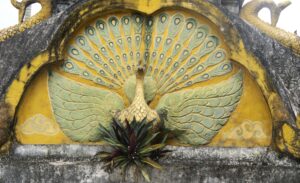 The map says I’m in China, but this corner of the kingdom as much resembles its southern neighbors as much as it does the far-off Beijing.
The map says I’m in China, but this corner of the kingdom as much resembles its southern neighbors as much as it does the far-off Beijing.
As I mentioned, Yunnan borders Laos and Burma, and is increasingly being connected to the south–to Thailand and Viet Nam as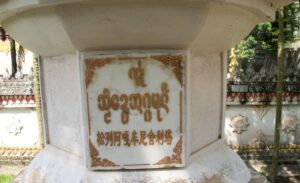 well. When I was in Burma a few years ago, I had our driver stop to see what was available in a store–all Chinese goods. The road to Mandalay was clogged with trucks making the trek from Kunming, and hotels jammed with Chinese drivers.
well. When I was in Burma a few years ago, I had our driver stop to see what was available in a store–all Chinese goods. The road to Mandalay was clogged with trucks making the trek from Kunming, and hotels jammed with Chinese drivers.
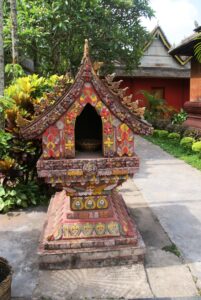 While those ties are increasingly supplemented with infrastructure (new roads and railroads) the ties are historical. The Dai minority here use a script that is Thai-like. The souvenir stores feature Thailand tee-shirts, and Burmese jewelry. Even closer (and unusual for China) is the Buddhism, which is of the colorful Southeast Asian variety, rather than the grey/brown earth tones of Japan/Korea and elsewhere in China.
While those ties are increasingly supplemented with infrastructure (new roads and railroads) the ties are historical. The Dai minority here use a script that is Thai-like. The souvenir stores feature Thailand tee-shirts, and Burmese jewelry. Even closer (and unusual for China) is the Buddhism, which is of the colorful Southeast Asian variety, rather than the grey/brown earth tones of Japan/Korea and elsewhere in China.
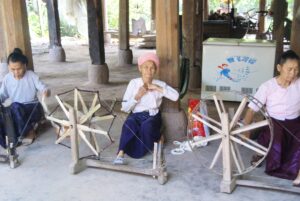 We went to a Dai village (increasingly rare, but preserved for historical and tourist purposes), to an old temple, where the guide said the Lord Buddha had come. The street names in town also have Chinese/English/Dai writing, in a frame that looks like it could have
We went to a Dai village (increasingly rare, but preserved for historical and tourist purposes), to an old temple, where the guide said the Lord Buddha had come. The street names in town also have Chinese/English/Dai writing, in a frame that looks like it could have 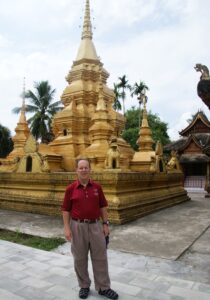 come from Thailand.
come from Thailand.
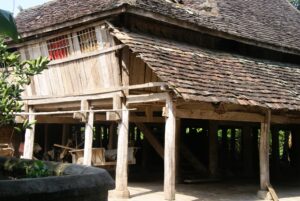
The village we stopped at had the two-story wooden homes that I’ve seen in Laos, Cambodia, and Burma. The first floor is reserved for animals and sundry (sundry today being pickup trucks), while the family lives on the second floor. I think this was like the lowland Lao homes we saw in Laos.
More and more, though, the Dai (and other minorities) are increasingly blended with the Han (modern?) culture. TV/Internet, and travel homogenize the world. If 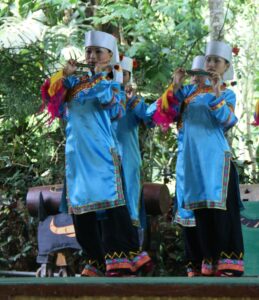 not for tourism, most of the world, I’m convinced, would look the same.
not for tourism, most of the world, I’m convinced, would look the same.
Change is coming here–in the far-flung reaches of the empire, and rather quickly. For example, Sunday was International Children’s Day (isn’t every day children’s day?). In the park in Lijiang, families picnicked with their children. Of the three generations, usually the grandparents were in the traditional garb, and maybe the young children. The parents and most of the young people looked like Memorial Day celebrants in the States.
As I said, the families are moving from the open two-story wooden houses into the cities, with modern, albeit functional housing (at least here in Jin hong).
Roads are improving and increasingly linking China together. It’s one of the advantages over India, an advantage that has made China the manufacturing hub of the world. When I came to Yunnan in 1990, we went from Kunming to Dali on the old Burma Road (a harrowing experience, but World War II opened Western China to the 20th century; Kunming was one of the hubs for flying equipment over the Hump–the Himalayas–and Chennault and the Flying Tigers was mentioned in one of the museums in Lijiang), the trip took 13 hours. Today it’s less than four, and there’s also an airport. The trip from Jin Hong to Kunming used to be 2 nights by bus. Today it is 7 hours, and when the new road is opened in a few months, it will be 4 hours (it’s about 45 minutes by plane).
 Xishuangbanna’s claim to fame is the water splashing festival, held in April to honor the past; one version of the story is that a devil-king ruled here, and his daughters wanted to help the people, so they cut off his head. Fire came out of the severed head, so they poured water on it. To commemorate the
Xishuangbanna’s claim to fame is the water splashing festival, held in April to honor the past; one version of the story is that a devil-king ruled here, and his daughters wanted to help the people, so they cut off his head. Fire came out of the severed head, so they poured water on it. To commemorate the 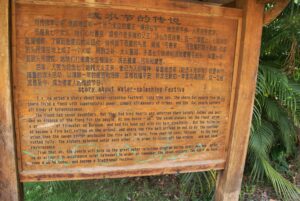 victory, they have a splashing party, which sounds like a good reason to party. Last night (having been to a village and a rainforest museum) I went to a spectacular show (the provincial government spent over $1 million U.S. on it) where I got splashed!
victory, they have a splashing party, which sounds like a good reason to party. Last night (having been to a village and a rainforest museum) I went to a spectacular show (the provincial government spent over $1 million U.S. on it) where I got splashed!
It hasn’t dampened my enthusiasm to do something spectacular today that I’ve never done before, before embarking on my own long march back to Bloomington-Normal. I leave here at 6, for Kunming, spend overnight in Kunming, then travel for about 24 back to Chicago.
See you soon!